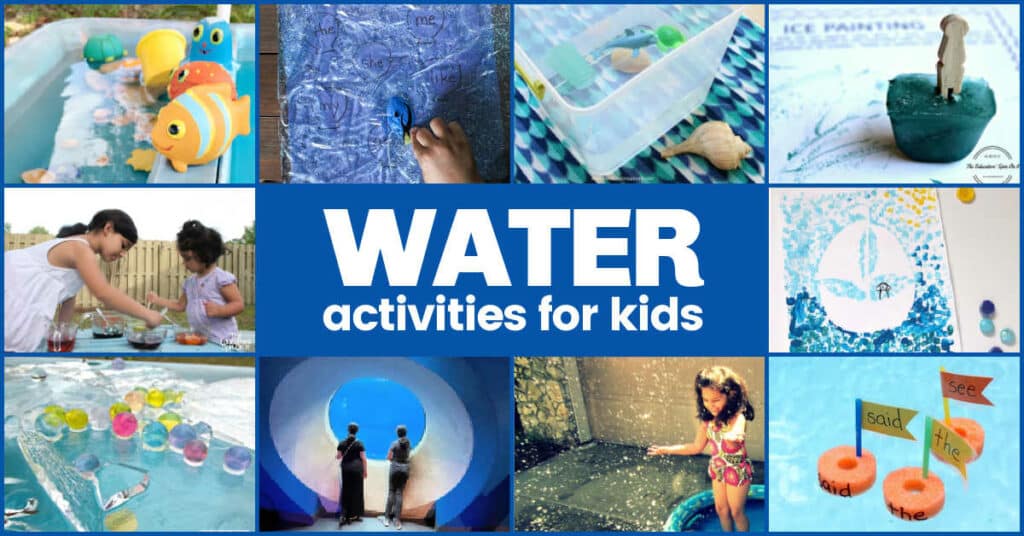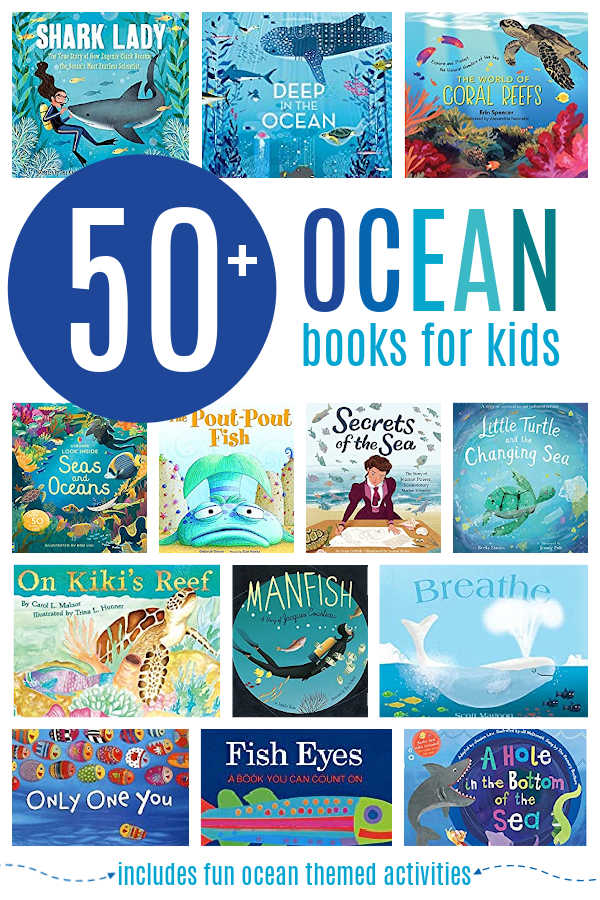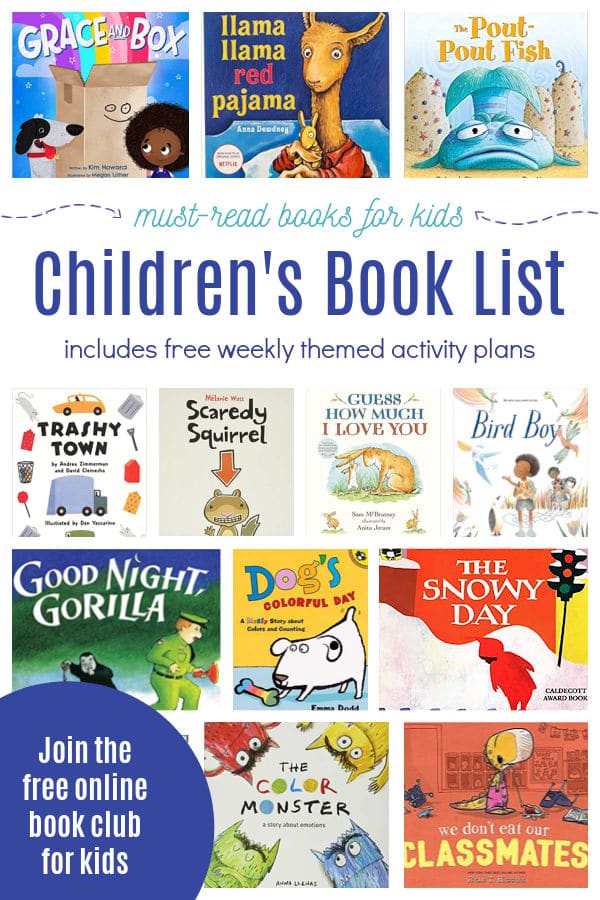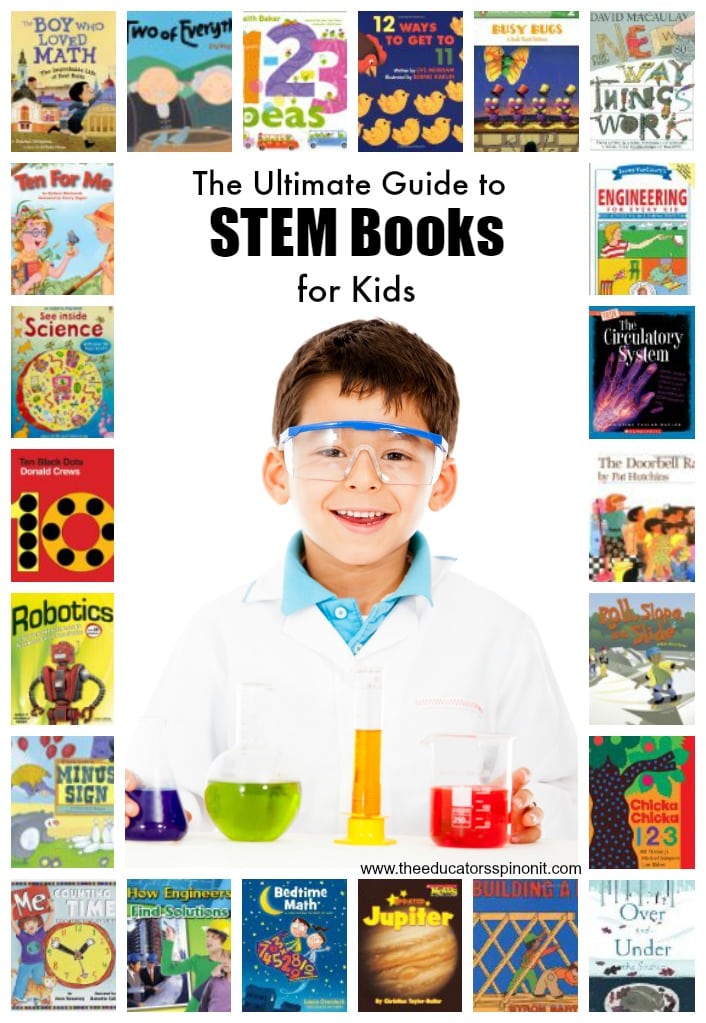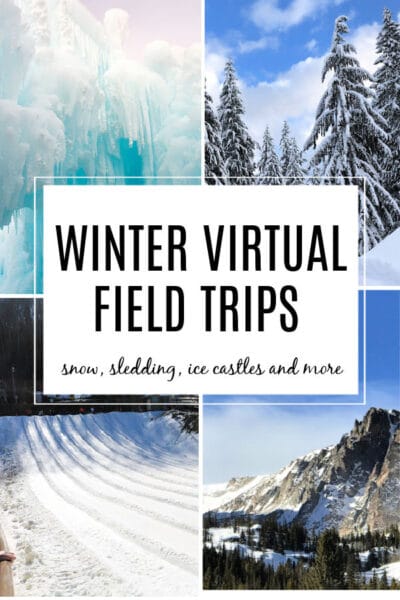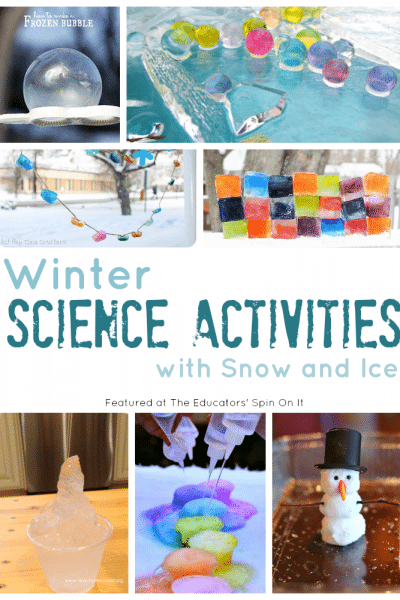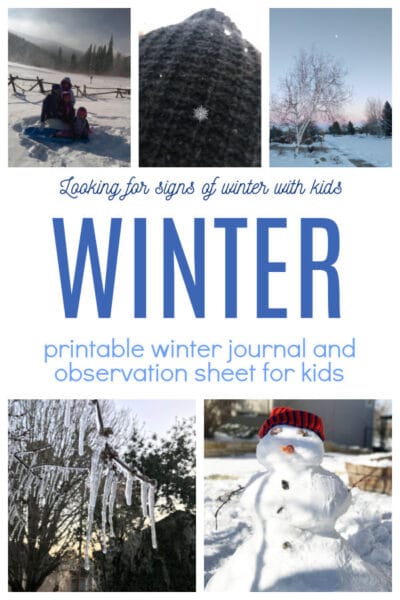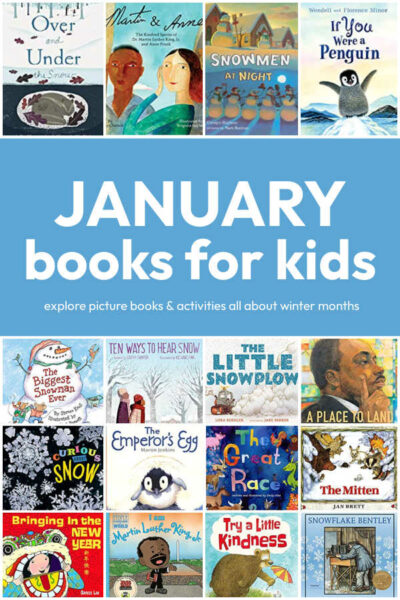The best collection of water books for kids! Help your child learn all about water through books and fun facts about the water cycle, water conservation, rain, rivers, lakes, oceans, and more.
Are you ready to dive into reading?
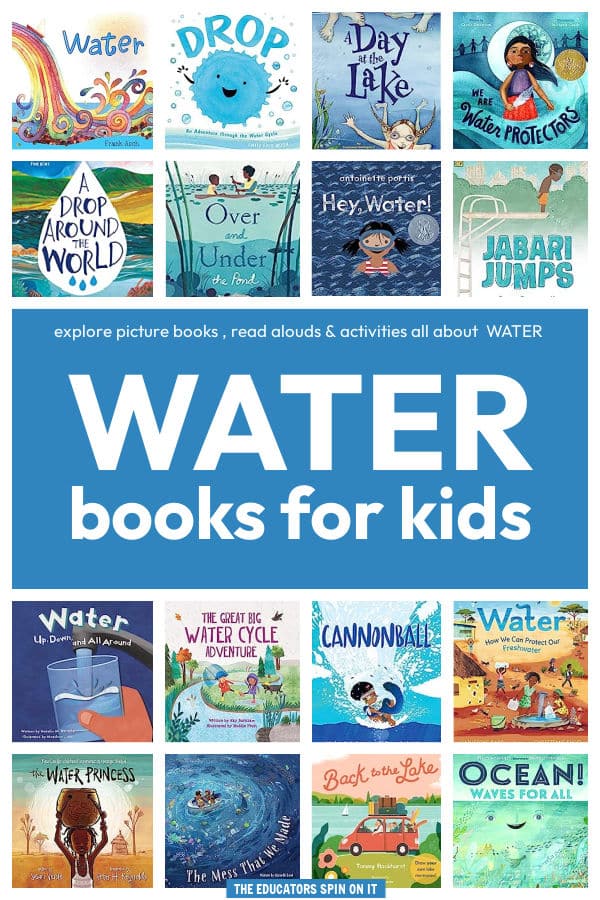
Water Books for Kids
Kids and water are like magnets. They are drawn to it and we know they’ll be drawn to this list of handpicked water books for kids.
There is a wide variety of books to choose from about water to read with your child or classroom. The large selection of water concepts makes it possible to keep reading about the topic of water throughout your school year.
We’ve put together a collection of water books that share about the water cycle, water conversation, swimming, rain, rivers, ponds, lakes, oceans, and more.
As you get started selecting your water book, here are some fun facts about water for kids to learn.
Fun Facts About Water for Kids
- 71% of the Earth’s surface is covered in water.
- About 60% of the human body is made up of water.
- The average person drinks about 8 glasses of water per day.
- Water can be found in three states: solid (ice), liquid, and gas (vapor).
- Water is essential for life.
- Water is used for drinking, bathing, cooking, and cleaning.
- Water is also used for irrigation, transportation, and energy production.
- Water is a renewable resource, but it is important to conserve it.
Learning Objective about Water for Kids:
Water is found on Earth in three main states: liquid, solid, and gas.
- Liquid water is found in oceans, seas, lakes, rivers, glaciers, and underground aquifers.
- Solid water is found in glaciers, ice caps, and snow.
- Gaseous water is found in the atmosphere as water vapor.
Water is also found in living things, such as plants and animals.
As you look through our water books list, we’ve included some fun water facts in each section to help you explain more about various ways we see water in our world with your child.
This post contains Amazon Affiliate links. As an Amazon Associate, I earn from qualifying purchases.
All About Water Books
Water is all around us, but does your child know this? Start with this selection of books that tells us all about water on our planet. Fun ways to observe it and find it in all parts of life.
Plus you can explore the importance of water play for kids.
- Hey, Water! by Antoinette Portis
- Water by Frank Asch
- Water! Water! Water! by Nancy Elizabeth Wallace
- I Am Water (Scholastic Reader, Level 1) by Jean Marzollo
- Blue Planet: Life In Our Oceans and Rivers by Moira Butterfield
- All the Water in the World by George Ella Lyon
- One Well: The Story of Water on Earth by Rochelle Strauss
- Water: A Deep Dive of Discovery by Christy Mihaly
- Water Can Be by Laura Purdie Salas
- Hello, Puddle! by Anita Sanchez
- Water Dance by Thomas Locker
- Be Thankful for Water: How water sustains our planet by Harriet Ziefert
- The Ultimate Book of Water by Anne-Sophie Baumann
- Water Land: Land and Water Forms Around the World by Christy Hale
ACTIVITY: Explore this collection of 25+ Water Activities for Kids. Our favorite with young children are these water table themes and activities.
Water Cycle Books for Kids
One key concept about water that your child should explore and understand is the water cycle. It’s something they will learn throughout their years in science at school. This a topic I wish we spent more time on to learn more about protecting our waterways and groundwater.
There are three different forms of water: liquid, solid, and gas.
- Liquid water is the most common form of water and is what we drink and use for everyday activities.
- Solid water is known as ice and forms when liquid water cools below 0 degrees Celsius (32 degrees Fahrenheit).
- Gaseous water is known as water vapor and forms when liquid water evaporates.
Water can also exist in other forms, such as water vapor in the atmosphere and water ice in glaciers and snow.
- Drop: An Adventure through the Water Cycle by Emily Kate Moon
- The Great Big Water Cycle Adventure by Kay Barnham
- The Water Cycle (Learn About: Water) by Sonia Black
- The Flow of Water: Water Circulation by Da-jeong Yu
- The Water Cycle at Work by Rebecca Jean Olien
- Water: Up, Down, and All Around by Natalie Myra Rosinsky
- Water Cycles (DK Life Cycles) by DK
- A Drop Of Water: A Book of Science and Wonder by Walter Wick
- Let’s Investigate with Nate #1: The Water Cycle by Nate Ball
- Rosa Explores the Water Cycle by Jessica Spanyol
- A Drop Around the World by Barbara Shaw McKinney
- Water Is Water: A Book About the Water Cycle by Miranda Paul
- The Magic School Bus Wet All Over by Pat Relf
- Fresh Air, Clean Water Our Right to a Healthy Environment by Megan Clendenan
- Water: Exploring the Elements by Simone Akasha Nofel
- The Water Cycle (One Planet) by Annabel Griffin
- Agent H2O Rides the Water Cycle by Rita Goldner
- How Does Water Move Around?: A Book About the Water Cycle by Madeline J. Hayes
Swimming Books for Kids
Swimming with your child can be so much fun! It also can be something that makes parents nervous as we work to keep our children safe. Water safety is a key lesson for our kids to learn about.
Reading books about swimming can be a helpful key to this. Plus for those little ones who are nervous about learning to swim, books can be a helpful comfort to be brave.
Have you signed your child up for swimming lessons?
- Jabari Jumps by Gaia Cornwall
- Bubbles . . . UP! by Jacqueline Davies
- Cannonball by Sacha Cotter
- Leo Can Swim by Anna McQuinn
- Pool Party by Amy Duchêne
- Llama Llama Learns to Swim by Anna Dewdney
- Rosie the Dragon and Charlie Make Waves by Lauren H. Kerstein
- 1, 2, 3, Jump! by Lisl H. Detlefsen
- Curious George Goes Swimming by H. A. Rey
- Summer Vacation, Here I Come! by D.J. Steinberg
- I See Summer by Charles Ghigna
- Dino-Swimming by Lisa Wheeler
- Together We Swim by Valerie Bolling
- Daniel Learns to Swim (Daniel Tiger’s Neighborhood) by Alexandra Cassel Schwartz
- Froggy Learns to Swim by Jonathan London
- Maisy Learns to Swim by Lucy Cousins
- Peppa Goes Swimming by Scholastic
- Saturday Is Swimming Day by Hyewon Yum
ACTIVITY: Play the Drip Drip Drop Game by the pool or try one of our 20+ Pool Noodle Games!
Rain Books for Kids
Children and let’s be honest adults are fascinated by rain. There’s something special about watching it fall and wash over the earth. Watched it fall from our rooftops and into the gutters screaming to our little ones, come play in the water! I hope you get a few chances to head outside to play in the rain.
Here are some fun facts about rain for kids…
- Rain is water that falls from clouds.
- Clouds are made up of tiny water droplets or ice crystals.
- The water droplets or ice crystals in clouds stick together and grow bigger until they can no longer float in the air.
- When the water droplets or ice crystals are too heavy, they fall to the ground as rain.
- Rain is important for plants and animals.
- Plants need rain to grow.
- Animals need rain to drink and to water their food.
- Rain also helps to clean the air and the environment.
- Rain is a natural resource that we should all appreciate.
One thing I’d encourage you to consider at your home is installing a rain barrel or building a rain garden as we teach our kids more about water conservation.
- The Rhythm of the Rain by Grahame Baker-Smith
- Singing in the Rain by Tim Hopgood
- Come On, Rain! by Karen Hesse
- Hello, Rain! by Kyo Maclear
- Little Raindrop by Igloo Books
- Ethan The Raindrop by Sean Patrick Guidera
- Rain Dances by Daniel Clavio
- Rain by Cynthia Rylant
- Who Likes Rain? by Wong Herbert Yee
- I Am the Rain by John Paterson
- The Big Umbrella by Amy June Bates
- Rain by Sam Usher
- Tap Tap Boom Boom by Elizabeth Bluemle
- Look, It’s Raining by Mathieu Pierloot and Maria Dek
- The Pink Umbrella by Amelie Callot and Genevieve Godbout
- Rain Boy by Dylan Glynn
- I Like the Rain by Sarah Nelson
- Watersong by Tim McCanna
- Splish! Splash!: A Book About Rain by Josepha Sherman
- After the Rain by Rebecca Koehn
- This Raindrop: Has a Billion Stories to Tell by Linda Ragsdale
ACTIVITY: For some fun with art and rain, try this Rain Painting Craft! Sneak in a little letter fun with this Cloud Themed Spelling Game.
Water Conservation Books for Kids
One really important topic about water to talk about with your child is water conversation. Here are some tips for talking to kids about Water Conversation.
- Make it fun and interactive. Kids are more likely to remember information that they find interesting and engaging. Try using games, activities, and stories to teach them about water conservation.
- Be age-appropriate. For younger children, focus on simple concepts like turning off the faucet when they brush their teeth. For older children, you can discuss more complex issues like water pollution and the effects of climate change on water resources.
- Be positive and encouraging. Water conservation can seem like a daunting task, but it’s important to focus on the positive aspects of saving water. Talk about how water conservation can help the environment and save money.
- We Are Water Protectors by Carole Lindstrom
- The Water Princess by Susan Verde
- Water: How We Can Protect Our Freshwater by Catherine Barr
- Why Should I Save Water? by Jen Green
- The Mess That We Made by Michelle Lord
- What a Waste: Trash, Recycling, and Protecting our Planet by Jess French
- The Story of Conservation by Catherine Barr and Steve Williams
- Rocket Says Clean Up! by Nathan Bryon
- Why Water’s Worth It by Water Environment Federation
- Watch Over Our Water by Lisa Bullard
- Something Happened to Our Planet: Kids Tackle the Climate Crisis by Marianne Celano PhD and Marietta Collins PhD
- Sadiq and the Clean Water Crew by Siman Nuurali
- You Wouldn’t Want to Live Without Clean Water! by Roger Canavan
- Cleaning Water (Water In Our World) by Rebecca Jean Olien
- Ice Boy by David Ezra Stein
- Ice: Chilling Stories from a Disappearing World by DK
- Glacier on the Move by Elizabeth Rusch
- The Lonely Polar Bear by Khoa Le
River Books for Kids
Moving water is something pretty magical as a kid. Humans are drawn to the sound of running water for many reasons. Rivers are important because they provide water for people and animals, and they help to create jobs and industries.
Explore these fun facts about Rivers…
- The longest river in the world is the Nile River, which is 4,132 miles long.
- The Amazon River is the largest river in the world by volume of water.
- The Mississippi River is the longest river in the United States.
- Rivers are important sources of water for drinking, irrigation, and transportation.
- Rivers are home to many different kinds of plants and animals.
- Rivers can be dangerous, so it is important to be careful when swimming or playing near them.
- Rivers are beautiful and can be a lot of fun to explore.
Here are a few of our favorite river books for kids.
- Great Rivers of the World by Volker Mehnert
- A River by Marc Martin
- Song of the River by Joy Cowley & Kimberly Andrews
- What Is A River? by Monika Vaicenavičiene
- Amazing Rivers: 100+ Waterways That Will Boggle Your Mind by Julie Vosburgh Agnone
- A is for Aquifer by Ann English
- The River: An Epic Journey to the Sea by Patricia Hegarty
- The River That Flows Beside Me by Charlotte Guillain
- They Call Me River by Maciek Albrecht
- Martin and the River by Jon-Erik Lappano
Pond Books for Kids
The main difference between a pond and a lake is their size. A pond is a small body of water, while a lake is a larger body of water. Ponds are also typically shallower than lakes, with an average depth of less than 10 feet. Lakes, on the other hand, can be much deeper, with an average depth of over 100 feet. All the water in a pond is shallow enough to allow sunlight to reach the bottom. This causes plants to grow at the bottom of ponds as well as on their surface.
- Ponds are often home to small fish, frogs, and turtles, while lakes can support larger fish, such as bass and trout.
- Ponds are usually formed by natural processes, such as when a stream or river is dammed up.
- Ponds are often used for recreation, such as fishing, swimming, and boating. Lakes are also used for recreation, but they are also used for drinking water, irrigation, and transportation.
Here are a few stories bout ponds to read with your child.
- Llama Llama Let’s Clean Up the Pond! by Anna Dewdney
- One Quiet Pond by Nicole M. Gray
- Pond Walk by Nancy Elizabeth Wallace
- In the Small, Small Pond by Denise Fleming
- A Different Pond by Bao Phi
Of Walden Pond: Henry David Thoreau, Frederic Tudor, and the Pond Between by Lesa Cline-Ransome
- Over and Under the Pond by Kate Messner
- The Water Hole by Graeme Base
ACTIVITY: Have some fun in the pond with these LEGO Pond Animal Reading Activity or create your Fly Frog Toss Game.
Lake Books for Kids
Lakes can be formed by natural processes, such as when a glacier melts, or by human activity, such as when a dam is built. Lakes are much deeper than ponds, with an average depth of over 30 feet.
Lakes are formed in a variety of ways, including:
- Volcanic activity: When a volcano erupts, it can create a crater that fills with water to form a lake.
- Glaciers: As glaciers move, they can carve out depressions in the land that can later fill with water to form lakes.
- Erosion: Over time, water can erode the land, creating valleys and depressions that can fill with water to form lakes.
- Tectonic activity: When the Earth’s tectonic plates move, they can create faults and fractures in the land that can fill with water to form lakes.
- Drainage: When a river is blocked, it can create a lake behind the blockage.
Lakes are important ecosystems that provide habitat for a variety of plants and animals. They also play a role in the water cycle, helping to regulate the Earth’s climate.
Here are a few of our favorite lake books for kids.
- The Vanishing Lake by Paddy Donnelly
- Back to the Lake by Tommy Rockhurst
- Lake Life with You by Cindy Jin
- The Big Blue Lake by Robert W Armstrong
- Tallulah: Mermaid of the Great Lakes by Denise Brennan-Nelson
- A Day at the Lake by Stephanie Wallingford and Dawn Rynders
- Rattletrap Car by Phyllis Root
- The Great Lakes: Our Freshwater Treasure by Barb Rosenstock
- Hattie and Hudson by Chris Van Dusen
- W is for Waterfall: An Alphabet of the Finger Lakes Region of NY by Aileen Easterbrook
- Waterfalls (Our Exciting Earth!) by Tanner Billings
ACTIVITY: Make your own fish with this Open Ended Fish Art Project.
Ocean Books for Kids
It’s crazy to think how much water can be found in the Ocean. Did you know that it holds about 97 percent of the Earth’s water? If you’re teaching kids about water, then the ocean is one big topic to include.
Here are some additional ocean fun facts for kids.
- The ocean covers 71% of the Earth’s surface.
- The deepest part of the ocean is the Mariana Trench, which is 11,034 meters deep.
- The ocean is home to over 1 million different species of animals.
- The ocean produces half of the oxygen we breathe.
- The ocean absorbs carbon dioxide from the atmosphere, which helps to regulate the Earth’s climate.
- The ocean is a major source of food for people around the world.
- The ocean is a place of wonder and exploration.
Here are a few of our favorite ocean books. You can see our complete list of the Best Ocean Books for Kids for more book suggestions.
- Over and Under the Waves by Kate Messner
- Commotion in the Ocean by Giles Andreae
- Ocean! Waves for All by Stacy McAnulty
- Earth’s Incredible Oceans by Jess French
- The Big Book of the Blue by Yuval Zommer
- Follow the Water from Brook to Ocean by Arthur Dorros
- A Dive into the Deep by Tessa Pfeifer
- By the Sea: Life Along the Coast by Judith Homoki
ACTIVITY: Pick a few of these 30+ Ocean Activities for Kids to extend your ocean learning.
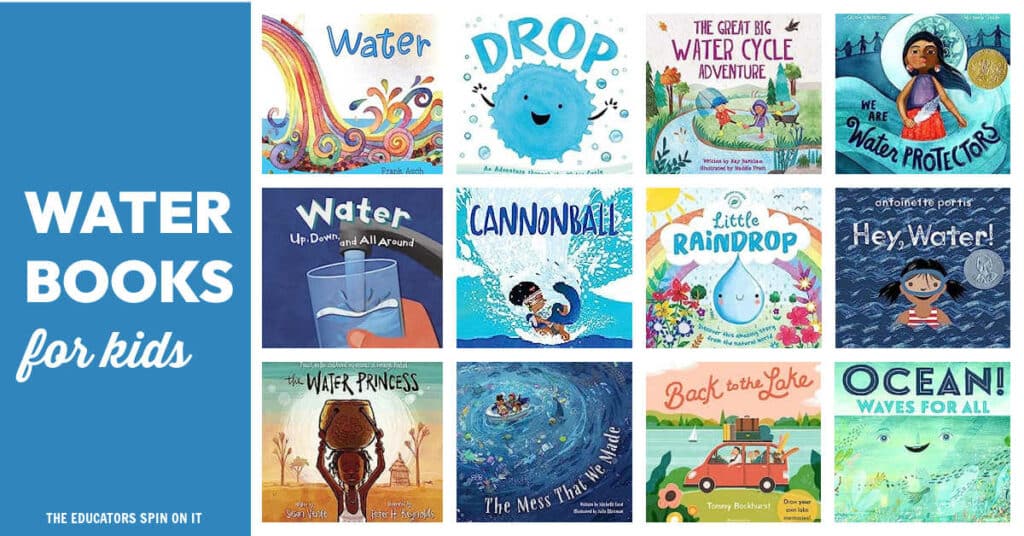
You can download our Water Book List! Just add your info here to download and print today!
How to Teach Kids About Water
Your child needs to learn about water for many reasons. Water is essential for life, and it is important for children to understand how to stay safe around water. They also need to learn about the importance of conserving water and how to protect our water resources.
Here are some specific reasons why children need to learn about water:
- Water is essential for life. Our bodies are made up of mostly water, and we need to drink water to stay hydrated. We also need water to cook, clean, and do many other activities.
- Water can be dangerous. Children need to learn how to stay safe around water, such as not to go near water without an adult, and to learn how to swim.
- Water is a precious resource. We need to conserve water so that we have enough for everyone. Children can learn how to conserve water by taking shorter showers, turning off the faucet when they brush their teeth, and fixing any leaks in their homes.
- Water can be found in many forms.
- Water is an important part of our environment. Children need to learn about the importance of protecting our water resources. They can learn about things like pollution and how to reduce their impact on the environment.
There are many ways to teach children about water. You can take them to the beach or the pool, read books about water, or do experiments with water.
You can also talk to them about the importance of water and how to stay safe around it.
Have a toddler or preschooler at home? Grab this water lesson plan for preschool!
For more book recommendations, try these popular book lists.
